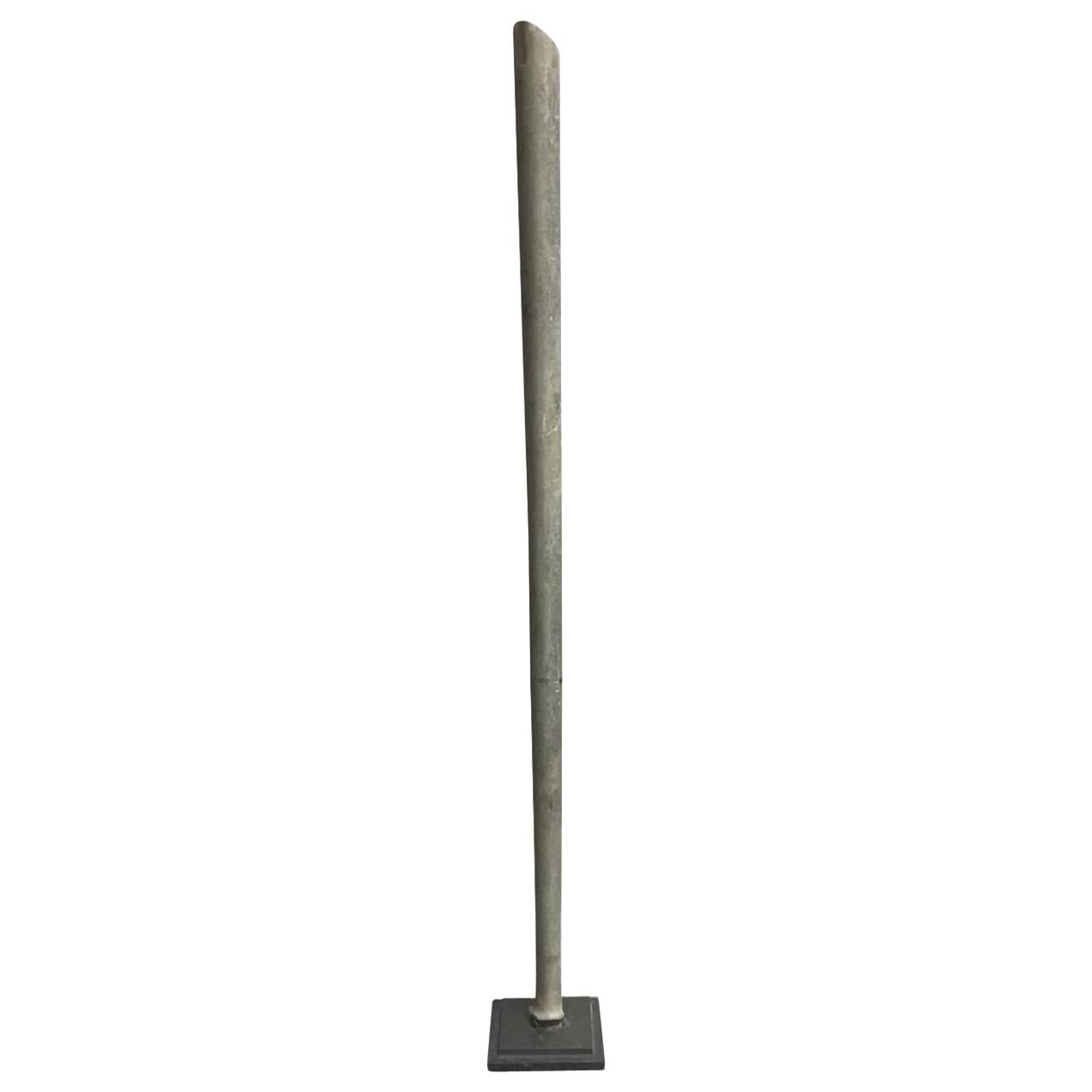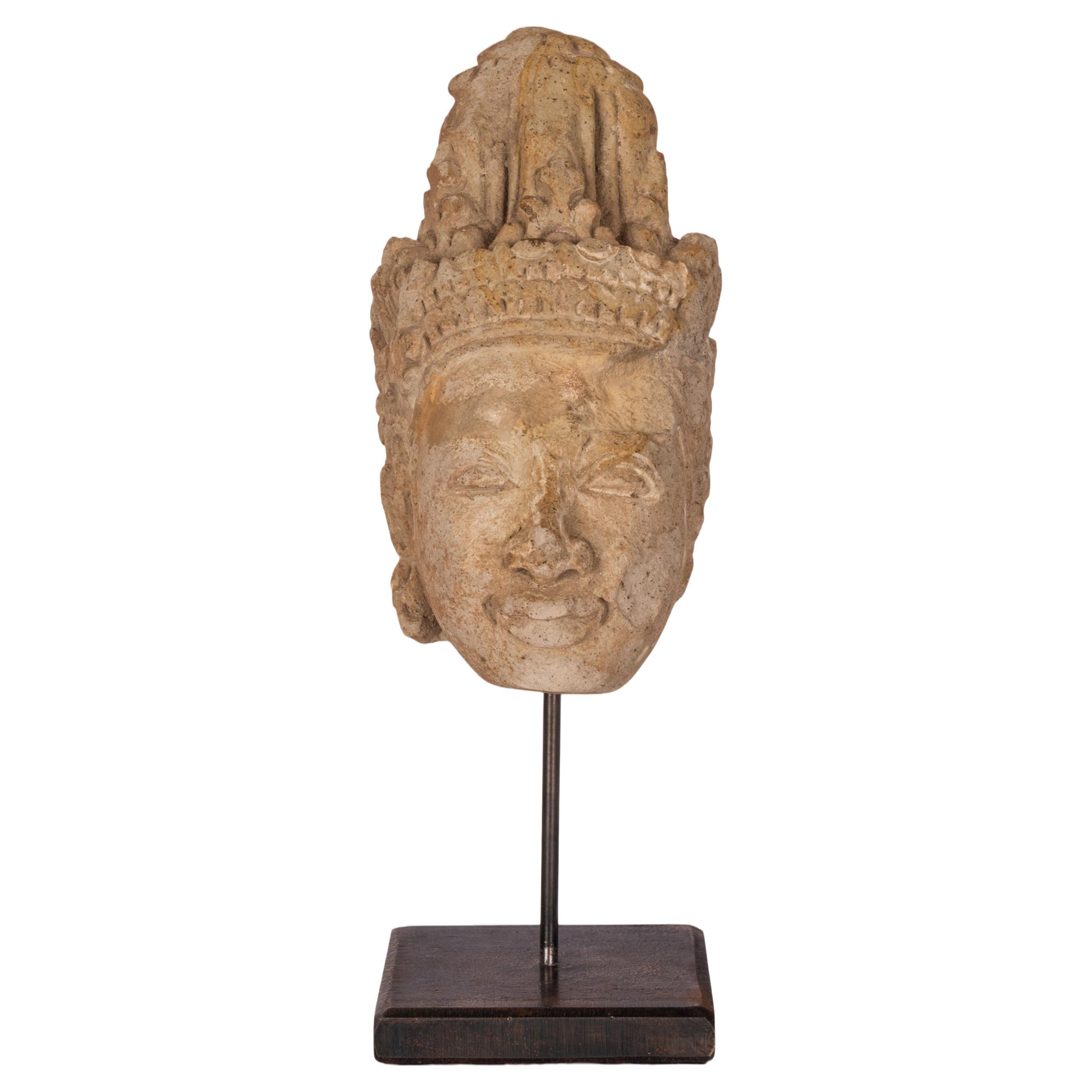Items Similar to Ancient Marble Portrait Bust of a Bearded Man possibly Lucius Verus
Want more images or videos?
Request additional images or videos from the seller
1 of 6
Ancient Marble Portrait Bust of a Bearded Man possibly Lucius Verus
About the Item
This impressive bust is depicted with head turned slightly to the right and gaze lifted. His eyes are articulated, with the pupils indicated with a drill, giving the face a striking realism. The shoulders are draped with a cloak. Straight brows sit beneath a mass of thickly curling hair, which continues to a full beard. It is worked with great skill, evident in the heavy drill work articulating and highlighting the voluminous curls, and the highly polished surfaces, giving the appearance of soft skin. The contrast between these textures gives a chiaroscuro affect which is one of the main traits of the best Antonine busts.
Roman marble portraits reached their apotheosis of craftmanship and technique under the Antonine emperors, as is evidenced in this masterful bust. The evolution of the style may be traced back to the emperor Hadrian, who was the first emperor to wear a full beard. The articulation of pupils and iris appears on busts of his lover Antinous, a novelty which continued in later Antonine portraits, such as this one. The features of this bust point to a possible identification of Emperor Lucius Verus, who had only one portrait type during his relatively short reign, identified by Max Wegner and appropriately named the ’Main Type’.
Emperor from 161 to 169, he ruled alongside Marcus Aurelius. Tall, blonde, and good-looking, Verus continued the Antonine tradition of a full beard, although he grew his to the length and breadth of a 'barbarian'. He is said to have taken great pride in his hair and beard, and at times even to have sprinkled gold dust on it to further enhance its golden colour. He was an accomplished public speaker, a poet and enjoyed the company of scholars. He was also an ardent fan of chariot racing, publicly backing the 'Greens', the horse racing faction supported by the plebians of Rome, as well as showing an interest in physical activities such as hunting, wrestling, athletics, and gladiatorial combat. Verus fell ill towards the end of 168 while returning from an expedition to the Danube frontier, dying a few days into 169. Marcus Aurelius buried him alongside their adoptive father Antoninus Pius in the Mausoleum of Hadrian, Rome.
Whilst this bust most closely resembles Lucius Verus of all the Antonine emperors, it could be said to be of late Antonine style, possibly a member of the ruling classes paying homage to the emperor by commissioning a bust in the Imperial style.
Condition
The nose was originally restored in the 19th or early 20th century, as evidenced by the techniques and materials used, and also the iron staining from the archaic use of metal pinning. The nose has since been re-restored. Otherwise, in very good state of preservation with natural weathering as expected with age. Mounted on old collection marble base.
Provenance
Previously in a European Private Collection, 19th or early-20th century (based on restoration techniques).
Private Collection of Dr Pierre Calvelli (1921-2015), Aix-les-Bains, France, from at least 1982 (accompanied by customs letter dated 4th June 1982, Switzerland to France), most likely acquired on the Geneva art market.
Thence by descent to his daughters Anne-Claude and Emmanuelle in 2015 (accompanied by French cultural passport 226780)
ALR: S00212712
With IADAA Certificate, this item has been checked against the Interpol database.
- Dimensions:Height: 22.84 in (58 cm)Width: 19.69 in (50 cm)Depth: 9.06 in (23 cm)
- Materials and Techniques:
- Period:
- Date of Manufacture:circa 161-169 A.D
- Condition:Repaired. The nose was originally restored in the 19th or early 20th century, as evidenced by the techniques and materials used, and also the iron staining from the archaic use of metal pinning. The nose has since been re-restored. Otherwise, in very good stat.
- Seller Location:London, GB
- Reference Number:
About the Seller
5.0
Vetted Seller
These experienced sellers undergo a comprehensive evaluation by our team of in-house experts.
Established in 1910
1stDibs seller since 2020
- ShippingRetrieving quote...Ships From: London, United Kingdom
- Return PolicyThis item cannot be returned.
More From This SellerView All
- Ancient Lustre Bowl with an IbexLocated in London, GBSmall shallow earthenware bowl decorated with lustre. With rounded sides and an everted rim, resting on a low foot-ring. Covered in an opaque white, probably tin, glaze with gold-bro...Category
Antique 15th Century and Earlier Iraqi Antiquities
MaterialsCeramic
- Two Glass Inlay PairsLocated in London, GBTwo pairs of two halves from the same bar, finely detailed, with pointed ears and eyebrows, opaque yellow face, opaque red on the mouth, nose, eyes and ears, translucent cobalt blue edges to the mouth, nose and ears, with translucent emerald green leaves above and between the translucent cobalt blue brows and eye line, translucent pink pupils, with translucent cobalt blie and opaque white snake scales below the face, in translucent cobalt blue matrix, cut in the lower part of a cartouche design. These rare heads might represent the Agathos Daimon, the tutelary deity of Alexandria, who was also identified with Serapis, the male counterpart of Isis-Thermouthis (who in turn was a graecisized form of the early snake harvest goddess Renenutet). In a statue of Isis-Thermouthis in Alexandria museum (no. 25773, ex-collection King Farouk I), reproduced in Gotten, Pharaonen, no. 151, the snake goddess...Category
Antique 15th Century and Earlier Egyptian Antiquities
MaterialsGlass
- Epitaph for Quirinia FeliciaLocated in London, GBA rectangular marble slab carved with the Latin inscription ‘QVIRINIAE C(retr.) L / FELICLAE / OLLAM DAT / C VALERIVS PYLODAMVS’, which translates as ‘Gaius Valerius Pylodamus gave t...Category
Antique 15th Century and Earlier European Classical Roman Antiquities
MaterialsBronze
- Bowl with Kufic InscriptionLocated in London, GBGlazed ceramic bowl with a convex wall and everted rim. With a cobalt blue inscription in the centre which reads, “baraka li-sahibihi” (blessing to its owner). Ceramics such as t...Category
Antique 15th Century and Earlier Antiquities
MaterialsCeramic
- 'Bellon' VaseLocated in London, GBA baluster-shaped ceramic vase with siliceous paste painted in manganese and cobalt, under a transparent glaze. With hand painted blue and white decorations. Stone paste or ‘fritware’ vessels with lustre, turquoise, white and cobalt blue glazes were famously crafted in the northern Syrian city of Raqqa, situated on the Euphrates River. They were often utilitarian in design, but elegant and intricate in decoration. This present example was most likely used as a storage vessel. Like many transportable ceramics in the region, it is possible this piece was exported out of the city, either to be traded or as a container for more expensive goods. Published Collection H Hoffmann...Category
Antique 15th Century and Earlier Antiquities
MaterialsCeramic
- Statuette of the Goddess NeithLocated in London, GBBronze statue of the goddess Neith, striding, her left foot extended forward. Her left hand is extended forward and formally held a papyrus sceptre, a fragmentary ankh is visible in ...Category
Antique 15th Century and Earlier Egyptian Egyptian Antiquities
MaterialsBronze
You May Also Like
- Ancient Bactrian Marble Idol Staff SceptorLocated in Vosselaar, BEA large Bactrian marble staff circa late 3rd-2nd millennium BCE. The Bactrian culture was discovered by Soviet archeologists in the 1970s in Afghanistan. Also called the Oxus culture...Category
Antique 15th Century and Earlier Afghan Antiquities
MaterialsMarble
- Early Chinese/Silk Road, Bronze Buddha/Bodhisattva Bust-Possibly 10thC or e 9687Located in Ukiah, CAEarly Chinese/Silk Road. Bust alone stands 7.5 inches tall. The crown, face, and overall look suggest an extremely early dating-possibly over 1000 years old. . Extremely powerful pre...Category
Antique 15th Century and Earlier Chinese Antiquities
MaterialsBronze
- Ancient Gandharan Carved Stucco Greco Buddhist Bodhisattva Head Bust 400-500 CELocated in Portland, ORAn ancient Gandharan carved stucco head, 4th-5th Century CE. This carved stucco head represents a Bodhisattva wearing an elaborate headdress, raised on a custom steel stand. The anci...Category
Antique 15th Century and Earlier Afghan Archaistic Antiquities
MaterialsStucco
- Statue of Man African ArtLocated in Milano, ITBeautiful painted wood statue from the 50's, belonging to African art. The statue of a man African art is made entirely of painted wood, depicts a man with...Category
Vintage 1950s North African Arts and Crafts Antiquities
MaterialsWood
- Small Hellenistic Parthian Marble Head of a Man, circa 2nd to 1st Century BCLocated in Austin, TXA small carved marble head of a man, Parthian Empire, Hellenistic Period, circa 2nd to 1st century BC, modern day Iran. The small marble head car...Category
Antique 15th Century and Earlier Persian Hellenistic Busts
MaterialsMarble
- Ancient Antique Carved Marble Greco-Bactrian Hippocampus Horse 2nd Century BCLocated in Portland, ORA rare Greco-Bactrian alabaster carving of a Hippocampus (Hippocamp) from antiquity, Central Asia or Afghanistan, circa 200 BCE. Finely carved from banded alabaster as a hippocampus ...Category
Antique 15th Century and Earlier Central Asian Classical Greek Antiquities
MaterialsAlabaster
Recently Viewed
View AllMore Ways To Browse
Bearded Iris
Lucius Verus Bust
Lucius Verus
Lucius Bust
Bust Of Antinous
Antique Curling Iron
Dior Gladiator
Marcus Aurelius Marble
Antique Chinese Snuff Bottles Inside Painted
Victorian Wicker Baby Carriage
Antique Korean Mirror Box
Ban Chiang Jar
Ban Prasat
Japanese Carved Nuts
Mahjong Set Tiffany
Mahjong Tiffany
Rolex Mantel Clock
Skull Dishes





